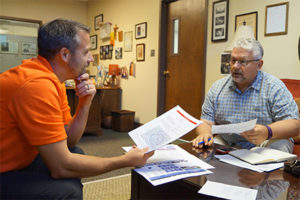
When communities change, it can be hard to notice from the inside.
For example, Kathryne Chapin asked members of Trinity Lutheran Church how many babies would likely be born in an upcoming year. The estimates were approximately 30 times smaller than the real number. Most members estimated (on average) that there would be 25 births within five miles of their church. The projected number was 749.
The projection came from a Lutheran Church Extension Fund (LCEF) demographic study. Kathryne understands how hard it can be to truly get a pulse on your local community. It isn’t always easy to spot population growth or other trends, especially in rural areas, like Trinity’s little corner of St. Charles.
Kathryne says, “People see the developments, but they don’t always know what exactly is happening inside them. They also see all the corn.”
She describes the LCEF demographic study as, “a Godsend with perfect timing.” The LCEF had
recently put together a study around the exact area she needed (though they often put together custom reports as needed).
If your eyes glaze over slightly when you hear the words, “demographic study,” you’re not alone. However, Kathryne says,
“It was so much more than just numbers. It really was a picture, or a snapshot of our community. In fact, the first page was called the ‘Story View,’ and that’s exactly what it did. It told the story of our community.”
Kathryne has relied on the LCEF demographic study for her graduate work in educational administration, as well as to assess the viability of expanding Trinity Lutheran School to include preschool. To get similar data from a private company would cost a great deal of money and take months and months. And even then, she might not be able to share the data as freely as the LCEF allows her to. She will be presenting her findings to the Board of Education, to evaluate the expansion of the school to early childhood.
If Trinity Lutheran moves forward with expanding their school, the plan is to start with infant care,
to foster a pipeline of students that will (hopefully) eventually enroll in kindergarten through eighth grade, the school’s current enrollment.
In addition to looking at early childhood opportunities, the congregation’s Ministry Action Team
is also looking at the study to consider opportunities for better community engagement. It will also help them consider how they can reach the community, while maintaining their traditional identity.
They plan to use the insights to plan meaningful community events, to market and to learn more about the people they wish to serve and attract.
“It’s amazing,” Kathryne says. “We can look at birth rate, death rate, migration and so much more. There are so many different types of diversity all around us. You can find diversity in the most seemingly homogeneous communities.”
Trinity Lutheran School started in the Civil War, and it’s easy to see how the landscape and people have changed over time. Kathryne says, “These could be the seeds we’re planting for generations to come, where someone might say her great, great grandmother attended our preschool.”
Contact Casey Carlson to reap the benefits of an LCEF demographic study. Email him at casey.carlson@mo.lcms.org or call (314) 590-6207.

